Tweet tweet! We're talking birds, and the incredible things they can do. Today we’re spotlighting five of the coolest recent stories in bird genetics: hummingbirds powering their lightning-fast flight; a gene that controls migration; why males have different colours to females; how light pollution makes sparrows sicker; and the bird trapped for thousands of years under the Siberian ice...
In this episode
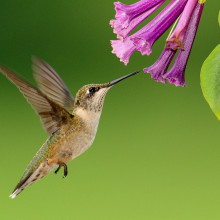
00:31 - How hummingbirds power their rapid flight
How hummingbirds power their rapid flight
Ariel Gershman, Johns Hopkins School of Medicine
The hummingbird is the smallest in the world. They can actually hover mid-air, and uniquely among birds, can fly backwards and upside-down. The quickest of them beats its wings more than eighty times per second. All this aerial acrobatics requires some unique tricks of energy and metabolism - and Phil Sansom heard from Ariel Gershman at the Johns Hopkins School of Medicine, who has been trying to figure out what in their genes makes all this possible…
Ariel - We're really interested in something that hummingbirds do called metabolic flux. They are able to maintain this extremely high metabolism, and extremely high blood sugar, that for most humans would be considered as diabetes; but hummingbirds are able to do this without getting any of the ailments associated with diabetes, like blindness, and kidney disease, and all of these other problems that humans who maintain this persistently high blood sugar often experience.
Phil - What's the flux part of that? Is it flux like changing really quickly?
Ariel - The flux is just this rapid shift that they're able to do. So when hummingbirds are eating, they're eating sugar from nectar, and they're able to use the sugar almost entirely to fuel their metabolism, or how they break down that sugar to make energy. But then once they stop feeding, they have to rapidly switch their metabolism to be able to use this fat that they store in their body to then be able to get energy, and power this extremely expensive hovering flight that they're able to do. And so if they weren't able to switch this metabolism so quickly, from their fed state to their fasted state, then they wouldn't be able to continue flying.
Phil - Oh my God, it almost sounds like one of those animals that hibernates in winter and then does all their eating in the summer, but over the course of what, minutes?
Ariel - Yeah. Over the course of 30 minutes is how quickly they're able to switch this fed to fasted metabolism.
Phil - What exactly are you doing to look into this metabolic flux, as you called it?
Ariel - We first had to actually sequence and put together their entire genome. And once we had the whole genome together, we then had to figure out where genes in the genome are. Because only about 1% of the genome actually codes for genes that end up making proteins. And then what we did was we sequenced all of the hummingbird RNA. If you can imagine. the genome is kind of like the blueprint for how to build the organism, whereas the RNA is more like what's actually being made to allow the organism to survive and persist.
Phil - How are you doing this here then, with both the DNA and the RNA?
Ariel - What we mainly focus on is called long read sequencing. Some people call it third generation sequencing. The typical, or the gold standard of DNA sequencing, is this second generation sequencing right now. And in second generation sequencing, it's extremely accurate, but we're only getting small pieces of DNA at a time. Where in third generation sequencing, we're actually sequencing these really, really long molecules of DNA. And if you can imagine, when you're putting together a puzzle, it's a lot easier to put together a puzzle with less pieces that are bigger than a puzzle with more pieces that are smaller. However we lose a little bit of the accuracy with long read sequencing, so it's more likely that there will be mistakes.
Phil - Do you do anything to compensate for that?
Ariel - Yeah, we do. Once we have the entire structure from the long read data we go in and we correct it with the accurate short read data. This is a process that in the field we call hybrid genome assembly.
Phil - Wow. And just for context, how big is the job? How many genes does a hummingbird have?
Ariel - Oh, a hummingbird has around 20 to 30,000 genes. Not that much different than a human actually.
Phil - That's, yeah, quite a few genes to get through...
Ariel - Yeah. And it's actually not even the region of the genome that codes for genes that's the hard part; it's really the rest of the genome, that we don't really know a lot about what it does, that's actually the hard part for genome assembly, because a lot of the genome is made up of repetitive DNA. And if you can imagine, if you have the same puzzle piece that fits in multiple locations, you really don't know where it actually goes.
Phil - And what do you do in that situation?
Ariel - The longer reads actually really help us out a lot there. Because when we have the repeat, if we can get the information on either side of it we can anchor it to the right region of the genome.
Phil - These hummingbirds, then, you're giving them a nice big meal, then taking a bunch of blood to get all their DNA and RNA, or what?
Ariel - We're actually taking their liver and their muscle tissue. So those are the really important metabolic tissues.
Phil - With all this incredible third generation sequencing, what are you finding in there?
Ariel - Wow. I wish I had like the cure to diabetes or something crazy... but we're finding a lot of differences in expression in thyroid hormone, which is along the lines of what we expected. What we're really looking for and hoping to find is these glucose transporters. Not a lot is really known about how glucose, sugar, actually gets into the hummingbird cells and how it happens so quickly. Hummingbirds don't seem to have a lot of these genes that humans have that allow sugar to enter our cells. So how was it entering in hummingbirds? We don't know yet. And we're really hoping to figure that out.
Phil - Do you have any personal favourite theories at the moment?
Ariel - I think that this glucose transporter that we're looking for that we don't think is present in hummingbirds... I think that it might be there, it's just that it's in a region of the genome that's so repetitive that previous people who have studied it, haven't been able to find it because of this repeat problem.
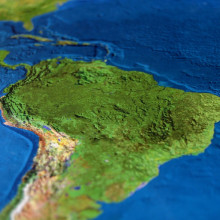
06:28 - Warbler migration affected by a single gene
Warbler migration affected by a single gene
David Toews, Pennsylvania State University
Plenty of birds fly vast distances towards the equator for winter and away again for summer, trying to stay ahead of the changing temperatures of the seasons. And now zoologists have found a single gene that seems to help control where they go. How does it work? The same way a gene inside a person might help them run faster, this one might be giving one group of warblers the stamina to fly further south than their neighbours. Phil Sansom heard from David Toews from Pennsylvania State University...
David - We found this gene that we believe is responsible for differences in migration in a Neotropical migratory wood warbler,
Phil - Really? The genes control it migrating? I would have thought that's all stuff it learns when it's a baby or something.
David - Yeah, these small songbirds, nobody really tells them where to go.
Phil - That's amazing. What are these birds then?
David - So these are Neotropical migratory wood warblers. There's about 110 species, but we were actually focused just on two: golden-winged warblers and blue-winged warblers.
Phil - What do they look like, these ones?
David - They're very colourful; but blue-winged warblers, unlike their name, are actually almost totally yellow with a little black face mask; and golden-winged warblers look very different, they're mostly white and they have a really distinct black face mask and throat. They're genetically very similar.
Phil - And when they migrate, where do they go?
David - These birds live primarily in the Eastern U.S. and Canada, but they migrate to Central and South America.
Phil - How do you figure this out, and track a bird to, I don't know, Central America?
David - That's actually one of the trickiest parts; following a tiny 12 gram bird over its entire annual cycle is logistically very difficult. We can't just put a GPS tracker on one of these birds because the battery that would be needed to power that and transmit data weighs about as much as the bird. And so my collaborators at the University of Toledo use these rather ingenious light loggers; these are little backpacks that you put on a bird where it's breeding, and it just captures passive light throughout the day. And long story short, if you know the precise sunrise, sunset, and midday points, you can get an estimate of latitude and longitude. Now you have to catch the bird the next year to download the data off these backpacks, because again, they don't have the capacity to transmit. So you inevitably... because these birds disperse, some of them don't all survive on their migration. If you are lucky enough or have enough money to put out enough of these backpacks, and get enough of them back, you can actually get individual-level movements for these migratory warblers.
Phil - Okay. So you're learning where the birds go. And then, what, comparing that to the genes?
David - Yeah, there was this really dramatic split between those birds that went all the way to South America to those that went to Central America. And so then we used whole genome resequencing. We found this very strong association with a single region of the avian sex chromosome, and within this single region, we found a single gene; and the gene is VPS13A.
Phil - Oh, that's a mouthful.
David - It is. So this basically is involved in the crosstalk between the nucleus and the mitochondria. This is kind of a gatekeeper protein that allows lipids to move back and forth.
Phil - Why would that be a thing for migration? I don't understand.
David - Yeah. So that is the $65 million question, and we don't know. There are some suggestions that it's involved in regulating these molecular products that are associated with stress, called reactive oxygen species. These are harmful byproducts that are produced when even you and I are exercising. And so the hand-wavey explanation for what different variants of this gene are doing is that it's helping regulate how much of the stressful by-product is being produced. But beyond that, we don't actually have an obvious clue of what this gene is doing.
Phil - If you're right: if you have one version of this gene, you're flying, you got a bit stressed from it, you drop down, you're in Central America; but you have the other version, you don't get as stressed, you're fine to keep flying for a bit, all the way down to South America.
David - Yeah, that's the idea.
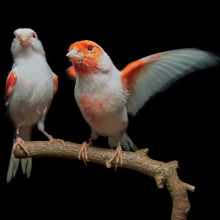
11:43 - Why mosaic canaries have sexual dichromatism
Why mosaic canaries have sexual dichromatism
Malzorgata Gazda, University of Porto
One feature you see in lots of birds is called sexual dichromatism - the scientific way of saying females are differently coloured to males. Think of mallard ducks, for example, or compare colourful peacocks to brown peahens. There’s a type of canary that has this too - it’s called the mosaic canary, and it’s a crossbreed between other canaries and a bird called a red siskin; and now scientists from the University of Porto in Portugal have found a gene that seems to be regulating the sexual dichromatism. Malgorzata Gazda explained to Phil Sansom…
Malgorzata - We found the gene that regulates the sexual dichromatism, differences in the colouration between males and females in birds.
Phil - That's something that's really common, right? A lot of birds have different coloured males and females.
Malgorzata - Yes. And some of them will have carotenoid colouration, so red, orange, or yellow colouration; and some of them will also have melanin colouration, so more brown and black.
Phil - Now what birds exactly are you looking at here?
Malgorzata - Domestic canaries. But to get them to sexual dichromatism, the breeders crossed the canaries with the red siskin, and then they got the breed we just called mosaic canaries.
Phil - This mosaic canary then, that's a crossbreed with the red siskins. This has sexual dichromatism which the other canaries don't?
Malgorzata - Yes. The wild canaries, they have a very slight sexual dichromatism. But then most of the domestic canaries, usually the male and female look the same.
Phil - What do the mosaic canaries look like then?
Malgorzata - Red or yellow. And then the male will have a lot of carotenoid colouration accumulated in the feathers in the face, in the wing, and in the tail.
Phil - Are they pretty then, these red or orange birds?
Malgorzata - Yes. Really pretty. But all canaries are really pretty!
Phil - How did you go about looking into the genes then?
Malgorzata - We sequenced the genomes of a couple of breeds of canaries. We found a very strongly differentiated region in the genome between regular canaries and mosaic canaries. The region was the same as in the red siskin; that confirmed that this region was introduced from the red siskin. This region encodes three genes, and excitingly BCO2 - beta-carotene oxygenase 2 - is the gene that is involved in the carotenoid metabolism. So this gene, basically it removes pigment from the tissue.
Phil - Oh, I thought you were going to say that they got a gene from the red siskins that made the carotenoids, not one that got rid of them.
Malgorzata - Yes. Exciting that it's the other way around.
Phil - That's strange, right?
Malgorzata - Yeah. A little bit. So actually, the females have to put in a lot of effort to remove the pigment and not deposit it in their feathers.
Phil - How can this gene then be doing different things in the female birds than in the male birds?
Malgorzata - It's probably regulated by the hormones. And then when it's active, the females remove the colouration, and in the males, the gene is not active, so they end up depositing the pigmentation in their feathers.
Phil - Does that tell you anything about how these birds evolved?
Malgorzata - Yes. So having one large effect gene that regulates the trait helps evolution to be quite quick, and they can gain or lose the trait pretty quickly.
Phil - So you're saying the fact that it's all controlled by one thing, means you can switch that one thing off and on really easily?
Malgorzata - Yes. Precisely.
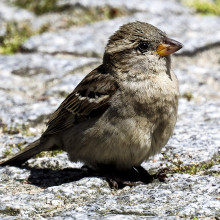
17:07 - Light pollution makes sparrows sicker
Light pollution makes sparrows sicker
Meredith Kernbach, University of South Florida
The coronavirus seems likely to have come to us from bats, possibly via a third party like a pangolin. If so, it would be far from the first time that an animal virus decided humans looked similar enough to make the jump - think of bird flu, mad cow disease, or even HIV. Zoologists from the University of South Florida have therefore been looking into the ways animals live closely alongside humans, and in particular testing out how light pollution affects sparrows that are carrying a common but dangerous disease called West Nile Virus. Phil Sansom heard from Meredith Kernbach...
Meredith - House sparrows, when they're exposed to light at night, they're not able to cope with infection with West Nile virus as well. They maintain the disease for longer and may actually die more easily from it.
Phil - So the light seemed to screw with their health in some way? And they couldn't deal with the virus as well?
Meredith - Right. Correct. So individuals are actually staying sick for longer, which may increase their opportunity to cause a West Nile virus outbreak in their area. West Nile virus is one of those things that spills over to people in the United States, and in Europe, and in Africa. And basically, we're broadly interested in why these diseases spill over. And so we chose light at night because we also know that light at night is rapidly expanding across all continents, except for Antarctica of course; but we know that it has a lot of other negative effects.
Phil - What was your version then, of a sparrow in a suburb? Presumably you didn't actually release sparrows with viruses into the suburbs of a nice city.
Meredith - Right. So we performed experimental infections in captivity, which has its caveats, because it's removed from nature. And these sparrows are housed basically on one side of the room, and we rig up a small light bulb, like a light bulb you'd find in your house, on the other side of the room, at a dim enough level that you might find in nature.
Phil - And then you give them a bit of the virus?
Meredith - Right. So we expose them to a very low amount of virus.
Phil - What does that look like - a sparrow with West Nile virus?
Meredith - It depends on the sparrow. There's a lot of different variation. Some birds will fluff up or look lethargic, and then other birds you'll never even know that they were sick.
Phil - If it's hard to tell whether these birds are actually that sick sometimes, what are you measuring to figure out how bad the light pollution is hitting them?
Meredith - We'll measure an individual's body mass, which indicates how well they're coping with disease. You might assume that a bird that's losing a lot of body mass is a very sick bird. And then we'll also take a blood sample to measure how much virus is in circulation, or how sick they are by how much virus they have in their blood sample.
Phil - And what do you find? How big a deal is light pollution for that?
Meredith - Light pollution actually does end up being a pretty big deal for these sparrows. The sparrows that are exposed to light at night actually have much higher amounts of virus in their blood. The hormone melatonin might be involved. It's a hormone that's secreted at night, but is suppressed in birds that are exposed to light at night. And melatonin is a regulator of the immune system, which means, without melatonin, your immune system might be all out of whack. Another mechanism is that the immune system will fluctuate throughout the day. So certain immune cells may be at higher concentrations, or there may be more of one immune cell during, say, the daytime. And so when they don't have the difference between light and dark anymore, their immune system may just get all scrambled up with not knowing what time of day it is.
Phil - Now, we're on Naked Genetics here. Do you have any clues for me from the genes of these sparrows?
Meredith - Yeah, absolutely. So, in another study we performed a transcriptomic analysis, which basically tells us which genes the sparrows are upregulating in order to cope with West Nile virus infection. And the birds who are exposed to light at night, upregulate these genes that are associated with say, pathogen resistance; which is counter-intuitive because you would expect that the birds with more virus would have worse resistance, but these birds that have more virus are actually upregulating these pathways earlier. And we also found from some of these other genetic signatures that individuals that are exposed to light at night are incurring more pathogen-induced damage, which means suffering a lot more from infection.
Phil - Huh. So it seems like whatever light is doing to these birds, the genes are desperately scrambling to keep up.
Meredith - Exactly.
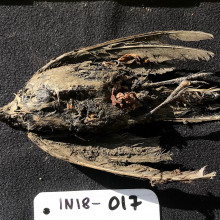
22:37 - The ice bird buried for 46,000 years
The ice bird buried for 46,000 years
Love Dalén, Centre for Palaeogenetics
Meet the ice bird, a treasure found under the Siberian permafrost. Love Dalén from Stockholm University told Phil Sansom the story…
Love - Back in 2018 I was part of a research expedition to a place called Belaya Gora in Northeastern Siberia, to go alongside Russian tusk hunters that were searching for mammoth tusks, going into these permafrost tunnels. And while we were there, one of the local Russians came out from one of the tunnels holding something very small in his hand. And it turned out to be a very small bird that looked extremely well preserved.
Phil - What did it look like?
Love - It was a bit dirty and wet, but otherwise it basically looked like a bird that had died just a few days ago.
Phil - Just like an ordinary brown bird?
Love - Yeah. I mean, given that it was partially covered in melted permafrost, which is muddy, it gave a quite sad impression initially, given that it was wet and so on; but it was pretty clear when we cleaned it up that all the feathers were preserved, and the overall shape, and you could see a small injury to its stomach where you could see some of the intestines and stuff like that. So it really looked like something had died only a few days ago.
Phil - Did you give the bird a name?
Love - Initially we had been calling the bird Ice Bird.
Phil - And you didn't know what kind of bird it was?
Love - We didn't know what kind of bird it was, what species it was...
Phil - What did you do to try and figure that out?
Love - We used the feathers to send for radiocarbon dating. This is a method that you can use to very accurately determine the age of an old specimen. It turns out that this part was 46,000 years old.
Phil - That so old!
Love - It is exceptionally old. It's very close to the actual limit of radiocarbon dating.
Phil - Did you figure out what kind of bird it was?
Love - Yep. We then extracted DNA from the bird and sequenced it, and this bird was from a species called horned lark.
Phil - Horned lark...
Love - Which is a small passerine bird that inhabits a large distribution in the Northern hemisphere.
Phil - What was the state of the DNA after 46,000 years in the Siberian ice?
Love - The DNA is in quite poor state. Normally DNA molecules are extremely long, and over time they fragment into smaller and smaller pieces, and this is how the DNA looked in this specimen as well. On top of that, the DNA was also contaminated by DNA from the environment: plants in the sediments, and bacteria that had probably been infesting the bird right after it died, and so on. By sequencing a lot of the DNA in there, we could pick out the few DNA sequences that actually came from the bird itself, and then we could puzzle together the whole mitochondrial genome: the small genome that exists inside the mitochondria, which are the small powerhouses inside all animal cells.
Phil - Did the mitochondria look like the mitochondria of a horned lark today? Or was it like, "clearly this is old mitochondria here"?
Love - This bird is clearly old because it doesn't look exactly like the modern horned larks. Today, horned larks are divided into a large number of different subspecies. And what we could show was that this particular bird actually seems to have belonged to a population that was a common ancestor of two subspecies that exist today.
Phil - So this is before the two species were two; this is the original one?
Love - Yes. Before the two subspecies evolved.
Phil - Does that tell you something about how these two subspecies evolved, or when they evolved?
Love - We think it does. So these two subspecies, one of them lives in Northernmost Russia today, and the other one inhabits the steppe in Mongolia. And so what we think happens is that back during the last Ice Age, the environment was comprised of a bit of a mosaic of different habitat types. And what happened at the end of the last Ice Age was that this mosaic stratified into the big biomes that we know today. So we do think that when the environment itself stratified into these large scale biomes, so did the horned larks, to the North and also to the South.
Phil - How incredible is it that this bird got injured, flew into the ice or something, and then 46,000 years later it's telling you all about how two different subspecies formed?
Love - It's quite amazing, isn't it? That something that old is preserved in such a perfect state. It's a bit like using a time machine where we can travel back in time and look at evolutionary change.
Phil - Maybe it's because I watched Jurassic Park last night, but it feels a bit like that. You know, they found the fly in the amber with the DNA from the dinosaur, and it's just this unbelievable event that tells you a million things.
Love - It really is. Actually one of our colleagues who was with us in Siberia, inside these tunnels, he kept whistling the theme song from Jurassic Park while we were there! Which was quite fitting.
Related Content
- Previous Can You Understand Me?
- Next Sperm Movement: Swim 'N' Roll










Comments
U could do one if you could
U could do one if you could attach bird wings (or any type of limb from an animal) and see if it could still work; move and stuff, ya know?
Add a comment